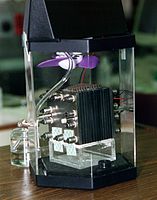
Photo from wikipedia
Abstract Proton exchange membrane (PEM) fuel cells operate with dead-ended anode in order to reduce system cost and complexity when compared with hydrogen re-circulation systems. In the first part of… Click to show full abstract
Abstract Proton exchange membrane (PEM) fuel cells operate with dead-ended anode in order to reduce system cost and complexity when compared with hydrogen re-circulation systems. In the first part of this work, we showed that localized fuel starvation events may occur, because of water and nitrogen accumulation in the anode side, which could be particularly damaging to the cell performance. To prevent these degradations, the anode compartment must be purged which may lead to an overall system efficiency decrease because of significant hydrogen waste. In the second part, we present several purge strategies in order to minimize both hydrogen waste and membrane-electrode assembly degradations during dead-ended anode operation. A linear segmented cell with reference electrodes was used to monitor simultaneously the current density distribution along the gas channel and the time evolution of local anode and cathode potentials. To asses MEA damages, Platinum ElectroChemical Surface Area (ECSA) and cell performance were periodically measured. The results showed that dead-end mode operation with an anode plate maintained at a temperature 5 °C hotter than the cathode plate limits water accumulation in the anode side, reducing significantly purge frequency (and thus hydrogen losses) as well as MEA damages. As nitrogen contribution to hydrogen starvation is predominant in this thermal configuration, we also tested a microleakage solution to discharge continuously most the nitrogen accumulating in the anode side while ensuring low hydrogen losses and minimum ECSA losses provided the right microleakage flow rate is chosen.
Journal Title: Journal of Power Sources
Year Published: 2017
Link to full text (if available)
Share on Social Media: Sign Up to like & get
recommendations!